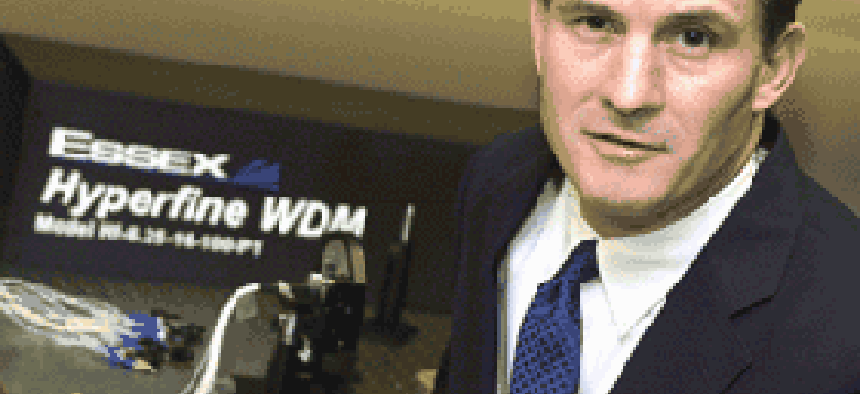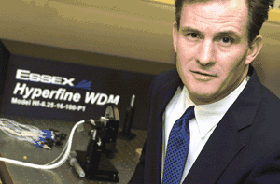Fast 50 companies find their government niche

Forensics, consulting, information technology services, engineering. The small businesses showing the fastest growth in the government sector also showcase a variety of services and niches that contractors can thrive in.
Forensics, consulting, information technology services, engineering. The small businesses showing the fastest growth in the government sector also showcase a variety of services and niches that contractors can thrive in.
The top company, Global Analytic Information Technology Services Inc. of Springfield, Va., provides information technology services and has found customers such as the Army and the Agriculture Department.
GAITS' government revenue grew at a compound annual rate of 171 percent between 1998 and 2002.
The annual Fast 50 list returns to Washington Technology this year after residing in other PostNewsweek Tech Media publications. But the list has been reinvented. In past years, Fast 50 companies were ranked based on the growth of their total revenue. The Washington Technology Fast 50 ranks IT companies based solely on the growth of their government revenue.
Twenty-one of this year's Fast 50 companies are IT services firms, and three of the top 10 firms provide consulting services.
One of these, No. 2 immixGroup Inc. of McLean, Va., offers consulting services to companies that want to do business with government agencies. The company, founded by Jeff Copeland and Steve Charles in 1997, went from $974,000 in 1998 to about $49.4 million in 2002, a growth rate of 166.8 percent.
At No. 8, Acquisition Solutions Inc. of Oakton, Va., has built its business by providing consulting services to government agencies that want to improve their procurement processes. Founded in 1996 by Chip Mather and Eben Townes, the company grew at a rate of 116 percent between 1998 and 2002, going from $475,000 to $10.3 million. Acquisition Solutions executives also write a column that is published in every other issue of Washington Technology.
Led by Jay Jayamohan, Comter Systems Inc. of Fairfax, Va., rounds out the top 10 with a 101.8 percent growth rate between 1998 and 2002. The company provides consulting services in areas such as enterprise resource planning, infrastructure and architecture and information security. Its revenue grew from $338,000 in 1998 to $5.6 million in 2002.
Other companies in the top 10 provide services such as systems integration, engineering and professional services.
Guidance Software Inc. of Pasadena, Calif., is the only company in which providing computer forensics services is its main line of business. The company, which had a growth rate of 135.9 percent between 1998 and 2002, sells products and services that help agencies and companies investigate cyberattacks.
Guidance isn't the only company that addresses a narrow niche.
For example, No. 40 Dynamic Animation Systems Inc. of Fairfax, Va., creates virtual reality applications -- in other words, high-tech video games -- for training. For the National Fire Academy, Dynamic Animation built a simulation laboratory and a national simulation and training network.
Dynamic Animation has seen its revenue grow by a compound annual rate of 55.6 percent, rising from about $1 million to $6.2 million between 1998 and 2002.
Other categories that had multiple entries include professional services with two companies, engineering with three, software development and engineering with five, and systems integration with six. *

The SBIR program helped Essex Corp. to commercialize its optoelectronic processor, which the Pentagon is using to improve missile tracking, said David Parry, a chief marketing officer for the Columbia, Md.-based company.
Olivier Douliery
Few companies offer technology more cutting edge than Essex Corp., creator of an optoelectronic processor that can transform radar images faster than traditional processors.
Who is one of Essex's biggest investors? The U.S. government, through the Small Business Innovative Research program.
And its biggest customer? The feds once again, buying the technology it paid Essex to develop.
"Essex has been commercializing [the processor] for the past several years. Without the SBIR program, we would not be in a position to continue that development," said David Parry, chief marketing officer for the Columbia, Md.-based company.
Although Essex employees formulated the basic outline of an optoelectronic processor, the company knew finding outside investment would be difficult. Plenty of development was needed, but the field of optical signal processing was too nascent to attract venture capitalists. They were more focused on more near-term returns of their investments. So the company turned to the SBIR program.
From 1992 to 2003, Essex received nine SBIR awards from the Defense Department, totaling about $6.1 million, to develop the Raptor optoelectronic processor. Raptor improves missile tracking because it can develop Doppler radar images more quickly than silicon-based processors.
The company since has sold more than $6 million worth of Raptor-based systems to the Missile Defense Agency. It also is looking to market the technology to cellular telephone service providers to improve call tracking.
Essex is one of many small businesses developing new ideas -- and growth -- with government awards. Federal agencies distribute about $1.6 billion a year to small businesses through SBIR and associated programs, according to Deborah Akwei, spokeswoman for the National Institutes of Health's SBIR program.
For agencies, the SBIR program is designed to procure technologies that aid their missions, but are too expensive to develop in-house and are not available commercially. SBIR program managers purposefully pick technologies that are too daring to interest the commercial venture capital community, reasoning that technologies closer to being commercialized would get funding anyway.
"The research may not lead to anything that's revolutionary for the agency, but the payoff can be tremendous," said Derrick Riddle, head of the SBIR program for the National Imaging and Mapping Agency. If the technology proves to be successful in the commercial marketplace, the funding agency can get a lower price, because the product will be mass produced.
Small businesses in the IT arena find no shortage of opportunities in the SBIR program, according to government and industry officials.
"Many agencies are interested in software development and research that can be used to develop advanced information technology devices," said Terry Payne, director of economic development for Oak Ridge Laboratories, which has partnered with small businesses on more than 40 SBIR-related projects over past three years.
THE 'REAL PAYOFF'
Established under the Small Business Innovation Development Act of 1982, the SBIR program mandates that all agencies, except intelligence agencies, with outsourced research and development efforts totaling more than $100 million a year devote 2.5 percent of these budgets to small-businesses efforts. Each agency manages its own program.
The early phases of an SBIR project usually receive modest amounts of funding. A phase 1 award, granted for a feasibility study, usually receives up to $100,000, while a phase 2 project provides up to $750,000 to build a working prototype. A company funded under the program retains the intellectual property rights of the technology, though the government has a license to use it.
A follow-on phase 3 award also may be given to small business to commercialize the technology developed in earlier awards. There are no limits to how much money an agency can give in a phase 3 award. However, the recipient also must find additional funding from another agency or company.
Recent program changes make it even more attractive for small technology companies. When Congress reauthorized the SBIR program in 2001, lawmakers changed the language to assure that small businesses would participate in any follow-on contracts that involved the technology they developed.
"This is a real payoff in terms of previous SBIR work," said David Metzger, a partner at the Washington law firm Holland and Knight LLP. "I've seen one $200 million phase 3 award and a $100 million phase 3. I'm sure there are many phase 3's that are less than that but are still considerable contracts."
Research funding is only a stepping stone to more lucrative government work. Once the company has developed a technology, it can create a service or solution around the innovation to sell back to the government.
'BEST THING' FOR BUSINESS
For Sentel Corp. of Alexandria, Va., an SBIR research effort led to a subcontractor role with Computer Sciences Corp., El Segundo, Calif., said James Garrett, Sentel president and chief executive.
The project stemmed from a 1989 NASA solicitation requesting an electronic system that would log the hundreds of mission-critical checks required before a rocket launch. Done by hand, such checks could take weeks.
Sentel, an engineering company that specializes in developing complex systems, submitted a proposal for a possible solution called the Electronic Portable Information Collection system, or EPIC. It runs on portable computer tablets that are linked to a central server.
NASA gave Sentel a $100,000 phase 1 award to study the feasibility of such a system. The results were promising, so NASA awarded Sentel a $600,000 phase 2 award. The agency went on to use the system for various launches, finding that it could reduce the time needed for system checks from 45 days to 3 days, according to Garrett.
Under the SBIR program licensing rules, Sentel keeps the intellectual property of EPIC. Sentel, like other SBIR award winners, is encouraged to further develop the technology for commercial and other government use.
Sentel found a second customer in the Air Force. CSC licensed EPIC as subcontractor to support Lockheed Martin Corp.'s work on the Air Force's Atlas V rocket. The company, which now has 325 employees, is also assembling a road show to speak with integrators and other businesses, such as automobile manufactures, Garrett said.
Caelum Research Corp., Rockville, Md., is another company that benefited from SBIR. Michael Yeh started Caelum in 1987 after working at NASA and seeing how algorithms that detect objects in space could be used elsewhere in industry.
Through SBIR phase 1 and 2 grants, he developed a series of powerful pattern-detection algorithms.
Eventually, NASA started using the software that Caelum developed for remote sensing, resulting in contracts that generate about $1 million in revenue annually for the company, said Yeh, now the company's chief technology officer. The Air Force and the National Oceanic and Atmospheric Administration use the technology as well.
Caelum also has adapted these algorithms for detecting cancers, using SBIR funding from the National Institutes of Health. NIH has invested in the technology primarily with the goal of developing it to help in earlier detection of lung cancer.
Caelum formed a partnership with General Electric Co., Fairfield, Conn., to commercialize NIH adaptation of its algorithms. GE may sell the software as part of a larger cancer detection solution.
Partnering gave Caelum valuable experience in moving the technology into the commercial realm.
"GE's software requirements are much more rigorous than SBIR's. GE assumes their service people will have very minimal knowledge of how to do an installation. It needs to have easy-to-use software," Yeh said. "So that takes a different level of software engineering to accomplish that."
Yeh is thankful for the opportunity SBIR provided Caelum.
"SBIR could be the best thing that ever happened to small business," he said. "We did benefit quite a bit from this program." *The Fast 50 companies were ranked based on how fast their government revenue grew from 1998 to 2003. This included federal, state and local revenue.
Companies were required to have a minimum of $100,000 in government revenue in 1998. Companies also had to meet the federal government criteria for a small business or be a member of the 8(a) program.
Each company provided Washington Technology with its government revenue numbers, along with a statement from an independent accountant verifying the accuracy of the numbers.
NEXT STORY: AT&T dials right number with Mercury, West Corp.

